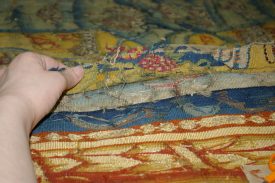In 2011, the Sheldon Tapestry was taken off display at the Market Hall Museum in Warwick and began a programme of specialist cleaning and conservation. Once it was cleaned, the conservators stitched and repaired the 400 year old tapestry, to ensure that we can continue to display, interpret, and appreciate it for years to come.
Over the months that the conservators were working with the tapestry, they got to see the whole thing close up and noticed small details that the weavers had added in. Removing the old lining from the back of the tapestry revealed some hidden secrets and the original colours.
Not the original border
The border around the tapestry map you see today is not the original; this was cut away, probably in the 17th century, and a plainer picture frame-style border was added. During conservation work, fragments of the highly decorated original border were found along the vertical sides. We know from the surviving sections of the Worcestershire map (currently on display at the Bodleian Library in Oxford), that the border had a yellow background with classical figures and buildings, vegetation and fruit. The small traces of the Warwickshire border give us hints of similar designs, such as grapes on vines, pears, and architectural elements with stylised marble.









Comments
Where can I access the digitised version of the tapestry?
Add a comment about this page